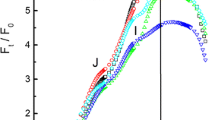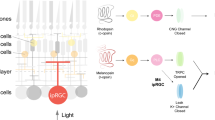Abstract
The photoreceptor cells of the nocturnal spider Cupiennius salei were investigated by intracellular electrophysiology. (1) The responses of photoreceptor cells of posterior median (PM) and anterior median (AM) eyes to short (2 ms) light pulses showed long integration times in the dark-adapted and shorter integration times in the light-adapted state. (2) At very low light intensities, the photoreceptors responded to single photons with discrete potentials, called bumps, of high amplitude (2–20 mV). When measured in profoundly dark-adapted photoreceptor cells of the PM eyes these bumps showed an integration time of 128 ± 35 ms (n = 7) whereas in dark-adapted photoreceptor cells of AM eyes the integration time was 84 ± 13 ms (n = 8), indicating that the AM eyes are intrinsically faster than the PM eyes. (3) Long integration times, which improve visual reliability in dim light, and large responses to single photons in the dark-adapted state, contribute to a high visual sensitivity in Cupiennius at night. This conclusion is underlined by a calculation of sensitivity that accounts for both anatomical and physiological characteristics of the eye.



Similar content being viewed by others
References
Aho A-C, Donner K, Hydén C, Larsen LO, Reuter T (1988) Low retinal noise in animals with low body temperature allows high visual sensitivity. Nature 334:348–350
Barth FG (2002) A spider’s world. Senses and behavior. Springer, Berlin
Barth FG, Seyfarth E-A (1979) Cupiennius salei Keys. (Araneae) in the highlands of central Guatemala. J Arachnol 7(3):255–263
Barth FG, Nakagawa T, Eguchi E (1993) Vision in the ctenid spider Cupiennius salei: spectral range and absolute sensitivity. J Exp Biol 181:63–79
Dubs A (1981) Non-linearity and light adaptation in the fly photoreceptor. J Comp Physiol 144:53–59
Greiner B, Ribi W, Warrant EJ (2004) Retinal and optical adaptations for nocturnal vision in the halictid bee Megalopta genalis. Cell Tissue Res 316:377–390
Grusch M, Barth FG, Eguchi E (1997) Fine structural correlates of sensitivity in the eyes of the ctenid spider, Cupiennius salei Keys. Tissue Cell 29(4):421–430
Hardie RC, Duelli P (1978) Properties of single cells in posterior lateral eyes of jumping spiders. Z Naturforsch 33c:156–158
Howard J, Dubs A, Payne R (1984) The dynamics of phototransduction in insects–a comparative study. J Comp Physiol A 154:707–718
Kelber A, Balkenius A, Warrant EJ (2002) Scotopic colour vision in nocturnal hawkmoths. Nature 419:922–925
Kirschfeld K (1974) The absolute sensitivity of lens and compound eyes. Z Naturforsch C 29:592–596
Land MF (1981) Optics and vision in invertebrates. In: Autrum H (ed) Handbook of sensory physiology. Vision in invertebrates, vol VII/6B. Springer, Berlin, pp 471–592
Land MF, Barth FG (1992) The quality of vision in the ctenid spider Cupiennius salei. J Exp Biol 164:27–242
Land MF, Nilsson D-E (2002) Animal eyes. Oxford University Press, New York
Laughlin S, Blest AD, Stowe S (1980) The sensitivity of receptors in the median eye of the nocturnal spider Dinopis. J Comp Physiol A 141:53–65
Rutowski LR, Warrant EJ (2002) Visual field structure in the Empress Leilia asterocampa leilia (Lepidoptera, Nymphalidae): dimensions and regional variation in acuity. J Comp Physiol A 188:1–12
Strausfeld NJ, Barth FG (1993) Two visual Systems in one brain: neuropiles serving the secondary eyes of the spider Cupiennius salei. J Comp Neurol 328:43–62
Strausfeld NJ, Weltzien P, Barth FG (1993) Two visual systems in one brain: neuropiles serving the principal eyes of the spider Cupiennius salei. J Comp Neurol 328:63–75
Warrant EJ (2004) Vision in the dimmest habitats on earth. Karl von Frisch lecture. J Comp Physiol A 190(10):765–789
Warrant EJ, Nilsson DE (1998) Absorption of white light in photoreceptors. Vision Res 38(2):195–207
Warrant EJ, Kelber A, Gislen A, Greiner B, Ribi W, Wcislo WT (2004) Nocturnal vision and landmark orientation in a tropical halictid bee. Curr Biol 14:1309–1318
Author information
Authors and Affiliations
Corresponding author
Rights and permissions
About this article
Cite this article
Pirhofer-Walzl, K., Warrant, E. & Barth, F.G. Adaptations for vision in dim light: impulse responses and bumps in nocturnal spider photoreceptor cells (Cupiennius salei Keys). J Comp Physiol A 193, 1081–1087 (2007). https://doi.org/10.1007/s00359-007-0263-5
Received:
Revised:
Accepted:
Published:
Issue Date:
DOI: https://doi.org/10.1007/s00359-007-0263-5




